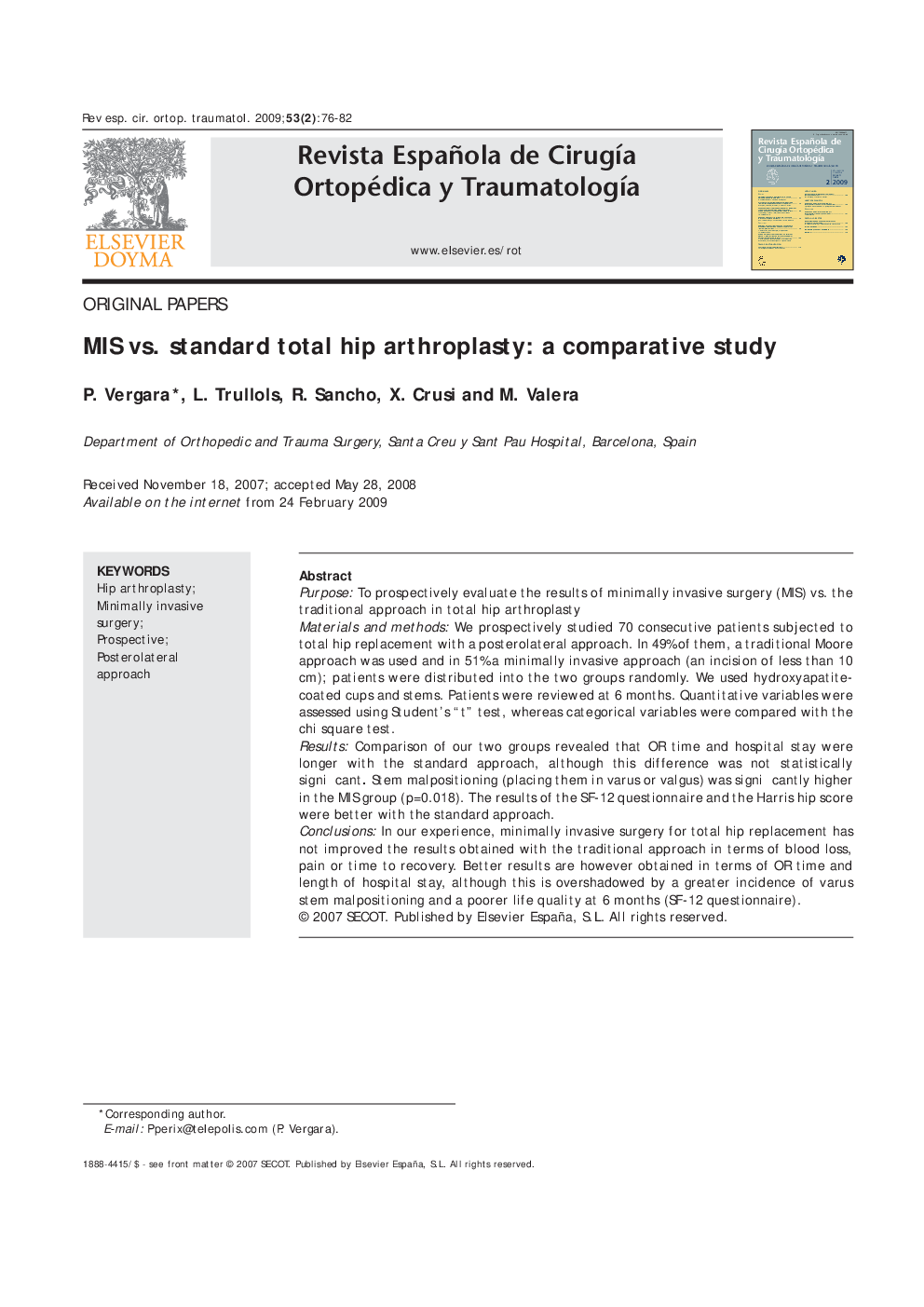| کد مقاله | کد نشریه | سال انتشار | مقاله انگلیسی | نسخه تمام متن |
|---|---|---|---|---|
| 4087717 | 1268056 | 2009 | 7 صفحه PDF | دانلود رایگان |

PurposeTo prospectively evaluate the results of minimally invasive surgery (MIS) vs. the traditional approach in total hip arthroplastyMaterials and methodsWe prospectively studied 70 consecutive patients subjected to total hip replacement with a posterolateral approach. In 49% of them, a traditional Moore approach was used and in 51% a minimally invasive approach (an incision of less than 10 cm); patients were distributed into the two groups randomly. We used hydroxyapatitecoated cups and stems. Patients were reviewed at 6 months. Quantitative variables were assessed using Student's “t” test, whereas categorical variables were compared with the chi square test.ResultsComparison of our two groups revealed that OR time and hospital stay were longer with the standard approach, although this difference was not statistically significant. Stem malpositioning (placing them in varus or valgus) was significantly higher in the MIS group (p=0.018). The results of the SF-12 questionnaire and the Harris hip score were better with the standard approach.ConclusionsIn our experience, minimally invasive surgery for total hip replacement has not improved the results obtained with the traditional approach in terms of blood loss, pain or time to recovery. Better results are however obtained in terms of OR time and length of hospital stay, although this is overshadowed by a greater incidence of varus stem malpositioning and a poorer life quality at 6 months (SF-12 questionnaire).
ResumenObjetivoevaluar de forma prospectiva los resultados de la técnica de abordaje mínimamente invasiva (MIS) frente al abordaje tradicional en la artroplastia total de cadera.Material y métodose estudió, de forma prospectiva, a 70 pacientes consecutivos intervenidos de artroplastia total de cadera por vía posterolateral, el 49% mediante abordaje tradicional de Moore y el 51% mediante abordaje reducido (menos de 10 cm) distribuidos aleatoriamente. Se emplearon cotilos y vástagos con recubrimiento de hidroxiapatita y se revisó a los pacientes a los 6 meses. Las variables cuantitativas se evaluaron mediante la prueba de la t de Student, mientras que las variables categóricas fueron comparadas mediante la prueba de la χ2.Resultadospartiendo de 2 grupos comparables estadísticamente, el tiempo quirúrgico y los días de ingreso fueron mayores en el abordaje estándar, aunque sin significación estadística. La mala posición de los vástagos (colocación de éstos en varo o valgo) fue significativamente mayor en el grupo MIS (p = 0,018). El test SF-12 y el test de Harris a los 6 meses fueron mejores en el abordaje estándar.Conclusionesen nuestra experiencia, el abordaje reducido para artroplastia total de cadera no ha mejorado los resultados de la técnica tradicional en pérdidas hemáticas, dolor o rapidez de recuperación. Presenta una mejoría en el tiempo quirúrgico y en los días de hospitalización, con una presencia de vástagos posicionados en varo significativamente mayor y una peor calidad de vida a los 6 meses (test SF-12) de los pacientes.
Journal: Revista Española de Cirugía Ortopédica y Traumatología (English Edition) - Volume 53, Issue 2, March–April 2009, Pages 76-82